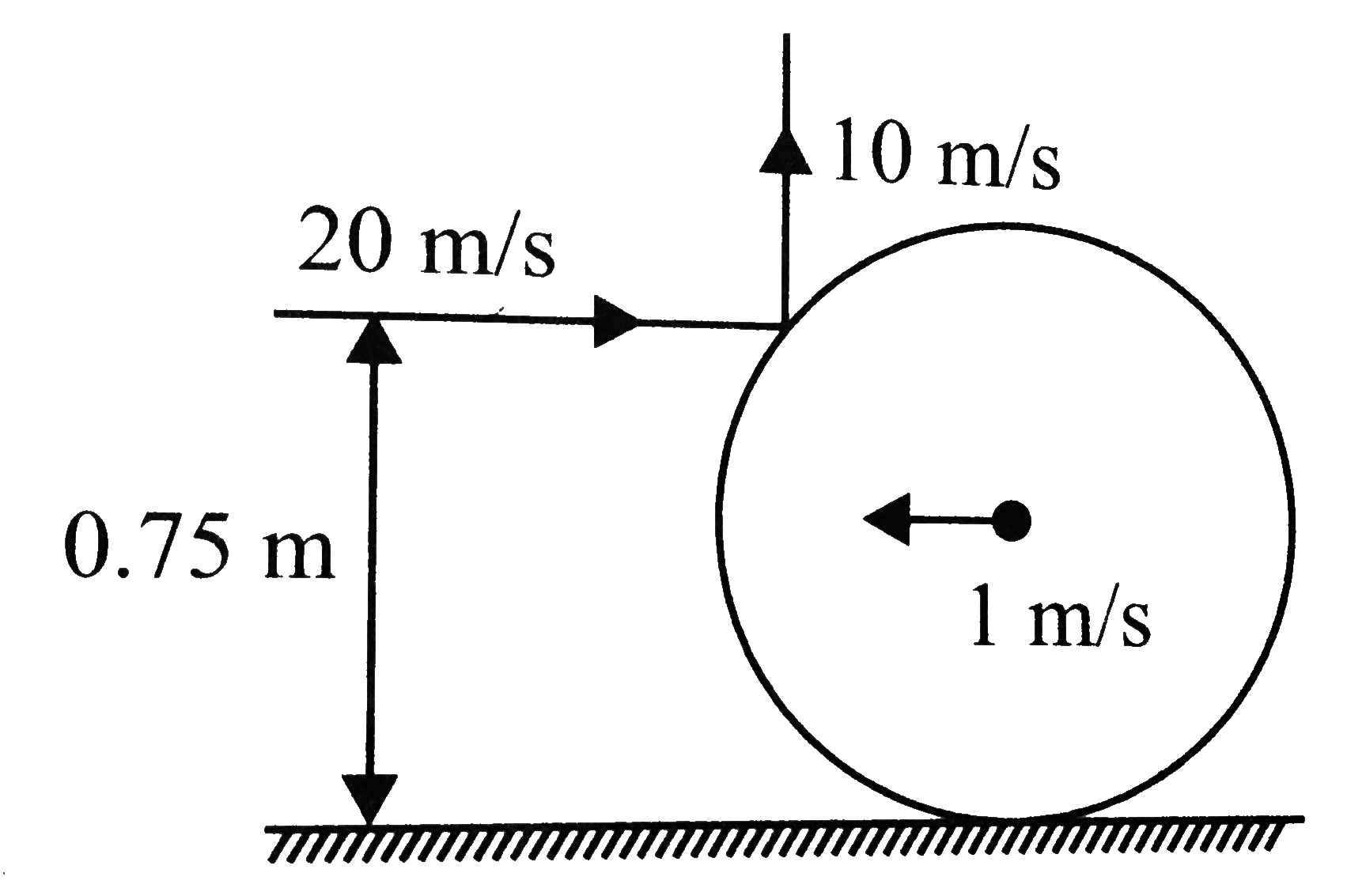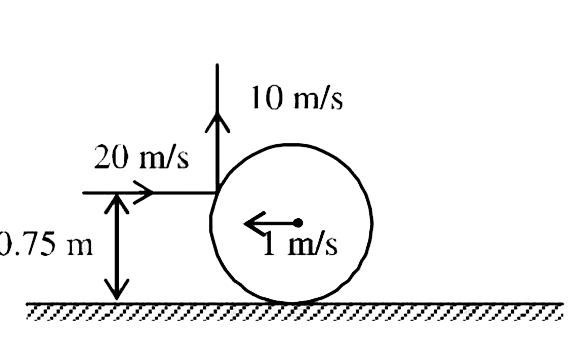A thin ring of mass 2kg and radius 0.5m is rolling without slipping on a horizontal plane with velocity 1m/s. A small ball of mass 0.1kg moving with velocity 20m/s in the opposite direction, hits the ring at a height of 0.75m and goes vertically up with velocity 10m/s. Immediately after the collision

the ring has pure rotation about its stationary CM
the ring comes to a complete stop
friction between the ring and the ground is to the left
there is no friction between the ring and the ground
The correct Answer is:A, C
The data is incomplte. Let us asumethat friction from ground on ring is not impulsive during impact.
From linear momentum conservation in horizontal direction, we have
(−2×1)+(0.1×20)=(0.1×0)+(2×v)

Here,v is the velocity of CM of ring after impact.
Solving, the above equation, we have v=0
Thus, CM becomes stationary, ∴ Correct option is (A).
Linear impulse during impact
(i) In horizontal direction, J1=Δp=0.1×20=2N−s
(ii) In vertical direction J2=Δp=0.1×10=1N−s

Angular impulse = Change in angular momentum
We have, 1×(√32×12)−2×0.5×12=2×(0.5)2[ω−10.5]
Solving this equation ω comes out to the positive or ω anticlockwise. So just after collision rightwards slipping is taking place.
Hence, friction is leftwards. Therefore, option ( C) is also correct.
Topper's Solved these Questions
- ROTATIONAL MOTION BOOK - VMC MODULES ENGLISHCHAPTER - ROTATIONAL MOTION EXERCISE - JEE Advanced (Archive) (LINKED COMPREHENSIVE TYPE)
7 Videos
- ROTATIONAL MOTION BOOK - VMC MODULES ENGLISHCHAPTER - ROTATIONAL MOTION EXERCISE - JEE Advanced (Archive) (ASSERTION & REASON TYPE)
2 Videos
- ROTATIONAL MOTION BOOK - VMC MODULES ENGLISHCHAPTER - ROTATIONAL MOTION EXERCISE - JEE Advanced (Archive) (SINGLE OPTION CORRECT TYPE)
26 Videos
- REVISION TEST-2 JEEBOOK - VMC MODULES ENGLISHCHAPTER - REVISION TEST-2 JEEEXERCISE - PHYSICS
25 Videos
- SIMPLE HARMONIC MOTION BOOK - VMC MODULES ENGLISHCHAPTER - SIMPLE HARMONIC MOTION EXERCISE - 7-previous year question
46 Videos
Similar Questions
A thin ring of mass 2kg and radius 0.5 m is rolling without on a horizontal plane with velocity 1m/s. A small ball of mass 0.1kg, moving with velocity 20 m/s in the opposite direction hits the ring at a height of 0.75m and goes vertically up with velocity 10m/s. Immediately after the collision

View Solutionwhat will be the wavelength of a ball of mass 0.1 kg moving with a velocity of 10ms−1 ?
View SolutionA ball of mass 0.2 kg moves with a velocity of 20m/sec and it stops in 0.1 sec , then the force on the ball is
View SolutionA ball of mass 0.2 kg moves with a velocity of 20m/sec and it stops in 0.1 sec , then the force on the ball is
View SolutionA uniform thin ring of mass 0.4kg rolls without slipping on a horizontal surface with a linear velocity of 10 cm/s. The kinetic energy of the ring is
View SolutionA body of mass 2kg moving with a velocity 3m/s collides with a body of mass 1kg moving with a velocity of 4m/s in opposite direction. If the collision is head on and completely inelastic, then
View SolutionA thin ring of mass m and radius R is in pure rolling over a horizontal surface. If v0 is the velocity of the centre of mass of the ring, then the angular momentum of the ring about the point of contact is
View SolutionIf a solid sphere of mass 1 kg and radius 0.1 m rolls without slipping at a uniform velocity of 1 m/s along a straight line on a horizontal floor, the kinetic energy is
View SolutionTwo smooth spheres A and B of masses 4kg and 8kg move with velocities 9m/s and 3m/s in opposite directions. If A rebounds on its path with velocity 1m/s, then
View SolutionA ball of mass 0⋅2 kg moving with a speed of 30 m/s strikes a bat returns in opposite direction with speed of 90m/s . Magnitude of change in momentu,m of ball will be
View Solution